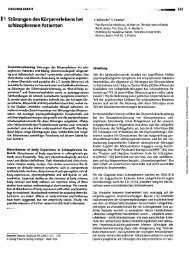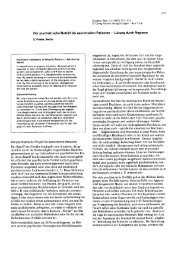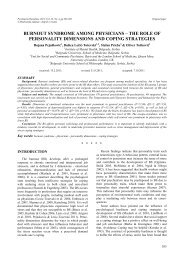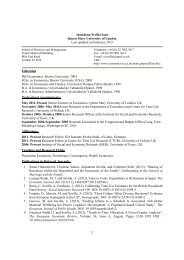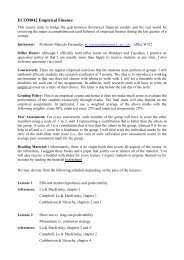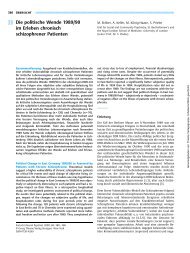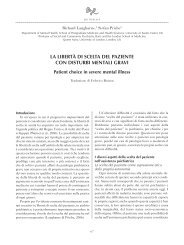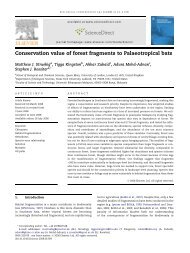Proofs - Personal Webspace for QMUL - Queen Mary, University of ...
Proofs - Personal Webspace for QMUL - Queen Mary, University of ...
Proofs - Personal Webspace for QMUL - Queen Mary, University of ...
You also want an ePaper? Increase the reach of your titles
YUMPU automatically turns print PDFs into web optimized ePapers that Google loves.
S58 U. Kluge et al. / European Psychiatry 27 (2012) / supplement n°2 / S56-S62<br />
5. Method<br />
The data were gathered as part <strong>of</strong> the project: European<br />
Best Practices in Access, Quality and Appropriateness <strong>of</strong> Health<br />
Services <strong>for</strong> Immigrants in Europe (EUGATE). Questionnaires<br />
were conducted with representatives from emergency departments,<br />
mental health services and primary care services, across<br />
all 16 participating countries. In each country, services were<br />
selected based on their location to ensure they provided care<br />
to immigrant populations. For each country, three districts<br />
within a major city with the highest proportion <strong>of</strong> immigrants<br />
were selected. In most cases the selected major city was the<br />
capital, with the exception <strong>of</strong> Lithuania (Kaunas) and Spain<br />
(Barcelona), and four cities were selected instead <strong>of</strong> three<br />
districts <strong>for</strong> Finland (Malax, Oravais, Pietarsaari & Vaasa) and<br />
the Netherlands (Amsterdam, the Hague, Rotterdam & Utrecht).<br />
These deviations refl ected the different distributions <strong>of</strong> emergency<br />
departments and mental health services in different<br />
countries. For a full list <strong>of</strong> services by country, see previous<br />
publication [32].<br />
Once cities and districts were identifi ed, representatives<br />
from three emergency departments, three mental health services,<br />
and nine primary care services were recruited in each <strong>of</strong><br />
the 16 participating countries. Resulting in respresentatives<br />
being contacted in 48 emergency services, 48 mental health<br />
services, and 144 primary care services across Europe. In total<br />
240 structured interviews were conducted on questions regarding<br />
service organisation, utilisation <strong>of</strong> services by immigrants,<br />
and monitoring systems within the services. An interview<br />
tool, developed using a Delphi process among partners within<br />
the participating countries, was used to collect the necessary<br />
data. This tool is publicly available from the EUGATE web page<br />
http: //www.eugate.org.uk/outcomes/index.html.<br />
Immigrants were defi ned as persons born outside <strong>of</strong> the<br />
country <strong>of</strong> current residence. In line with EU directives, this<br />
included: regular immigrants who are non- EU nationals but<br />
legally residing in the country (e.g. labour immigrants); asylum<br />
seekers awaiting a decision on their application; refugees as<br />
defi ned in Article 1 <strong>of</strong> the 1951 Convention; victims <strong>of</strong> human<br />
traffi cking; and irregular immigrants as defi ned as persons<br />
who have not been granted permission to enter, or to stay, in<br />
a given country (e.g. undocumented immigrants). Immigrant<br />
populations were not differentiated on grounds <strong>of</strong> ethnicity,<br />
culture or country <strong>of</strong> origin <strong>for</strong> this study, as these data were<br />
too heterogeneous <strong>for</strong> the participating countries.<br />
Table 1<br />
Proportion <strong>of</strong> services with available data on the immigration status <strong>of</strong> patients.<br />
Data available on All services<br />
(n=240)<br />
Data collected included: levels <strong>of</strong> service utilisation; patient<br />
characteristics; existence <strong>of</strong> any immigrant specifi c departments,<br />
programmes and policies; availability <strong>of</strong> specialised staff <strong>for</strong><br />
immigrant patients; staff diversity; interpreting services and<br />
evaluation issues. In<strong>for</strong>mation collected concerned the preceding<br />
12 months, or the most recent 12 month period <strong>for</strong> which fi gures<br />
were available. All data were descriptively analysed. The present<br />
paper describes fi ndings concerning service use by immigrants,<br />
the existence <strong>of</strong> data registers, the provision <strong>of</strong> interpreting<br />
services, and the presence <strong>of</strong> staff members from immigrant<br />
backgrounds. Results concerning other aspects <strong>of</strong> the dataset<br />
have been published elsewhere [32].<br />
Ethical approval was not required <strong>for</strong> this study in the<br />
participating countries, as no patient data were sought, and the<br />
study was regarded as service evaluation.<br />
6. Results<br />
6.1. Availability <strong>of</strong> data registers<br />
Only 114 <strong>of</strong> the 240 services (48%) kept data- based usability<br />
fi gures on use <strong>of</strong> services by all patients. In another 109 services<br />
(45%), reported rates were based on estimates. For the remaining<br />
17 health services (7%) neither data on actual fi gures nor<br />
estimated fi gures were made available to the interviewers.<br />
Data on immigrant status was available <strong>for</strong> regular immigrants<br />
in 8% <strong>of</strong> services, refugees 7% <strong>of</strong> services, and asylum<br />
seekers 5% <strong>of</strong> services. Those fi gures had been lower, than <strong>for</strong><br />
victims <strong>of</strong> human traffi cking (10% <strong>of</strong> services) or irregular immigrants<br />
(14% <strong>of</strong> services). See Table 1, <strong>for</strong> the number <strong>of</strong> all services<br />
with available data on different groups <strong>of</strong> immigrant patients by<br />
status. These fi gures do not necessarily indicate actual rates <strong>of</strong><br />
service usage by different immigrant groups based on status, but<br />
were more indicative <strong>of</strong> when in<strong>for</strong>mation was recorded and <strong>for</strong><br />
which groups based on immigration status.<br />
There were marked differences on the availability <strong>of</strong> actual<br />
data on all patients and immigrant patients <strong>for</strong> the different types<br />
<strong>of</strong> services. Comparing the three different types <strong>of</strong> services, the<br />
highest level <strong>of</strong> data availability <strong>for</strong> all patients was found in<br />
emergency departments. 69% (n=33) <strong>of</strong> emergency departments<br />
had usage data <strong>for</strong> all patients, followed by mental health services,<br />
where 56% <strong>of</strong> services (n=27) had data <strong>for</strong> all patients, whereas<br />
primary care services had the lowest proportion with 38% <strong>of</strong><br />
services (n=54). Variations were also noted between countries<br />
<strong>Pro<strong>of</strong>s</strong><br />
Primary care<br />
(n=144)<br />
Mental health<br />
(n=48)<br />
Emergency care<br />
(n=48)<br />
All patients in the service 48% (114) 36% (54) 56% (27) 69% (33)<br />
All immigrants patients 15% (35) 10% (14) 25% (12) 19% (9)<br />
Regular immigrant patients 8% (18) 6% (9) 15% (7) 4% (2)<br />
Asylum seeker patients 5% (13) 4% (5) 13% (6) 4% (2)<br />
Refugees patients 7% (16) 5% (7) 13% (6) 6% (3)<br />
Victims <strong>of</strong> human traffi cking patients 10% (24) 10% (14) 13% (6) 8% (4)<br />
Irregular (undocumented) patients 14% (34) 14% (20) 21% (10) 8% (4)




